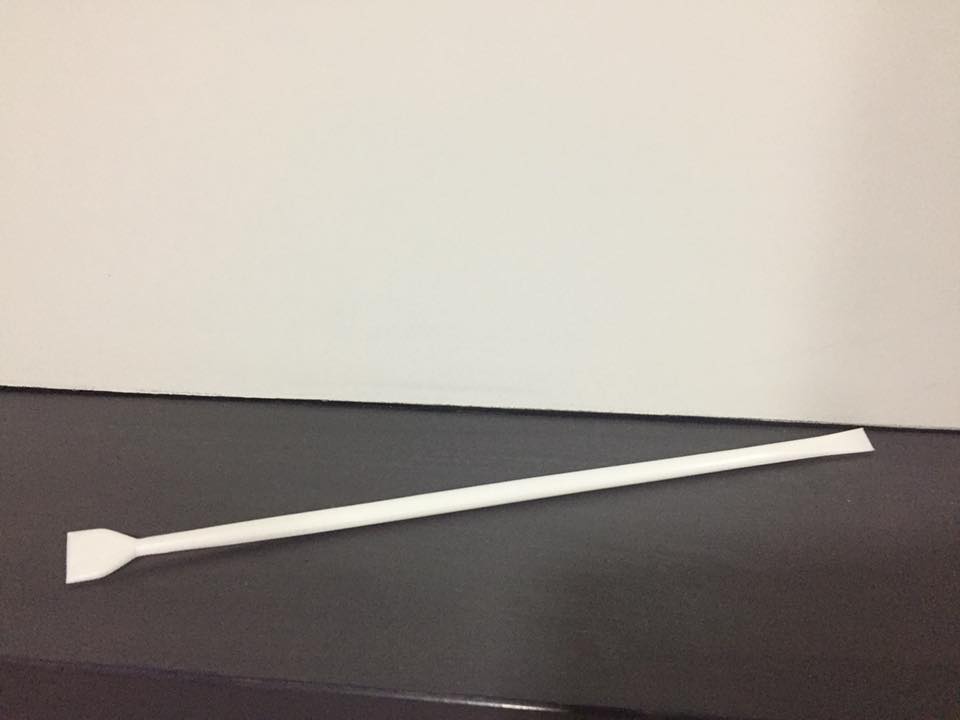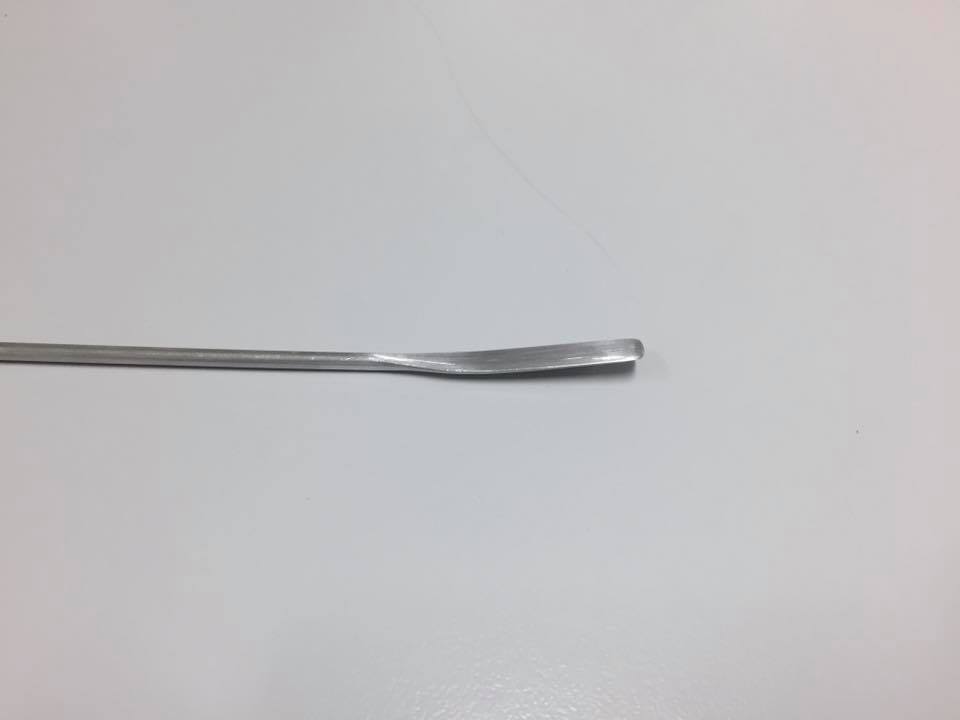Rubber Policeman on:
[Wikipedia]
[Google]
[Amazon]
A policeman is a hand-held flexible natural-rubber or plastic scraper. The common type of it is attached to a glass rod and used in
There is no answer on where the name "policeman" comes from. However, there are two assumptions: * It is like the police in that it protects the beaker from scratching. * It is like the police in that it gathers up any stray or escaped particles of precipitate on the beaker wall. The second speculation is the most likely the one since in the 1937 edition of Hackh's Chemical Dictionary “platinum policeman,” defined as ''“a platinum-iridium claw that fits over a glass rod and is used to hold a quantitative filter during ignition,”'' which the purpose of the policeman was to prevent the escape of stray filter paper from the crucible during the ignition process that causes thermal updrafts from the burner. Therefore, for policeman, it likely means to prevent the escape of stray precipitate.

 A policeman is generally a flexible natural-rubber blade attached to a glass rod, which is typically 5 mm to 6 mm diameter and 150 mm long. However, it also comes in various sizes and shapes depending on its uses. The rubber material provides chemical resistance. In some designs, there is no glass rod, but instead the whole item is made of plastic or stainless steel and is shaped into a spatula or scraper shape at the end.
A policeman is generally a flexible natural-rubber blade attached to a glass rod, which is typically 5 mm to 6 mm diameter and 150 mm long. However, it also comes in various sizes and shapes depending on its uses. The rubber material provides chemical resistance. In some designs, there is no glass rod, but instead the whole item is made of plastic or stainless steel and is shaped into a spatula or scraper shape at the end.
It also used in biological laboratories, to transfer tissue culture cells from a plate to a suspension. It feature is to prevent the glass rod from scratching or breaking glassware.
chemical
A chemical substance is a form of matter having constant chemical composition and characteristic properties. Some references add that chemical substance cannot be separated into its constituent elements by physical separation methods, i.e., w ...
laboratories
A laboratory (; ; colloquially lab) is a facility that provides controlled conditions in which scientific or technological research, experiments, and measurement may be performed. Laboratory services are provided in a variety of settings: physici ...
to transfer residues of precipitate
In an aqueous solution, precipitation is the process of transforming a dissolved substance into an insoluble solid from a super-saturated solution. The solid formed is called the precipitate. In case of an inorganic chemical reaction leading ...
or solid on glass surfaces when performing gravimetric analysis
Gravimetric analysis describes a set of methods used in analytical chemistry for the quantitative determination of an analyte (the ion being analyzed) based on its mass. The principle of this type of analysis is that once an ion's mass has been ...
. This equipment works well under gentle, delicate and precise requirement. A policeman also comes in various sizes, shapes, and types. Some of them come in one-piece flexible plastic version and some in stainless. The origin of the policeman and its name cannot be identified for sure but some clues led back to the 19th century from the chemist named Carl Remigius Fresenius.
Origin
In chemistry,gravimetric analysis
Gravimetric analysis describes a set of methods used in analytical chemistry for the quantitative determination of an analyte (the ion being analyzed) based on its mass. The principle of this type of analysis is that once an ion's mass has been ...
is essential. After precipitating the chemical element of interest, successfully transfer all of the precipitate
In an aqueous solution, precipitation is the process of transforming a dissolved substance into an insoluble solid from a super-saturated solution. The solid formed is called the precipitate. In case of an inorganic chemical reaction leading ...
to the filtration funnel for separation from the supernatant liquid is required. Normally, it used to be done by using a stream of distilled water from a wash bottle. However, such a way is ineffective because dense precipitates may become compacted at the bottom of the beaker or, in the case of light precipitates, may become dispersed on the walls of the beaker. Therefore, by using glass rod to take them off may result in poking a hole in the bottom of the beaker or scratching of the beaker wall. In the 19th century, German chemist, Carl Remigius Fresenius suggest the solution to overcome this problem.
Then rubber policeman also recorded in 1910 edition of J. C. Olsen's textbook of quantitative analysis that states "''...particles adhering to the glass must be removed by means of a so-called policeman, which is made by inserting the end of a rather thick large-sized glass stirring-rod into a short piece of rubber tubing. The rubber tube should be left protruding slightly beyond the end of the glass tube and sealed together with a little bicycle .e. rubbercement.''"
However, it seems that Olsen has nothing to do with the production and sales of this invention. Instead, Oesper Collections catalog indicated that policemen sold by the Henry Heil Company of St. Louis as early as 1904.There is no answer on where the name "policeman" comes from. However, there are two assumptions: * It is like the police in that it protects the beaker from scratching. * It is like the police in that it gathers up any stray or escaped particles of precipitate on the beaker wall. The second speculation is the most likely the one since in the 1937 edition of Hackh's Chemical Dictionary “platinum policeman,” defined as ''“a platinum-iridium claw that fits over a glass rod and is used to hold a quantitative filter during ignition,”'' which the purpose of the policeman was to prevent the escape of stray filter paper from the crucible during the ignition process that causes thermal updrafts from the burner. Therefore, for policeman, it likely means to prevent the escape of stray precipitate.
Structure

 A policeman is generally a flexible natural-rubber blade attached to a glass rod, which is typically 5 mm to 6 mm diameter and 150 mm long. However, it also comes in various sizes and shapes depending on its uses. The rubber material provides chemical resistance. In some designs, there is no glass rod, but instead the whole item is made of plastic or stainless steel and is shaped into a spatula or scraper shape at the end.
A policeman is generally a flexible natural-rubber blade attached to a glass rod, which is typically 5 mm to 6 mm diameter and 150 mm long. However, it also comes in various sizes and shapes depending on its uses. The rubber material provides chemical resistance. In some designs, there is no glass rod, but instead the whole item is made of plastic or stainless steel and is shaped into a spatula or scraper shape at the end.
Uses
A policeman can be used for cleaning the inside of glassware, or for getting the last bit of precipitate out of a vessel. Especially in chemical laboratories it is often used to transfer residues of precipitate or solid on glass surfaces when performing the gravimetric analysis.It also used in biological laboratories, to transfer tissue culture cells from a plate to a suspension. It feature is to prevent the glass rod from scratching or breaking glassware.
See also
* Glass rod *Spatula
A spatula is a broad, flat, flexible blade used to mix, spread and lift material including foods, drugs, plaster and paints.
In medical applications, "spatula" may also be used synonymously with tongue depressor.
The word ''spatula'' derives f ...
* Beaker
References
{{DEFAULTSORT:Rubber Policeman Laboratory equipment Microbiology equipment Chemical equipment